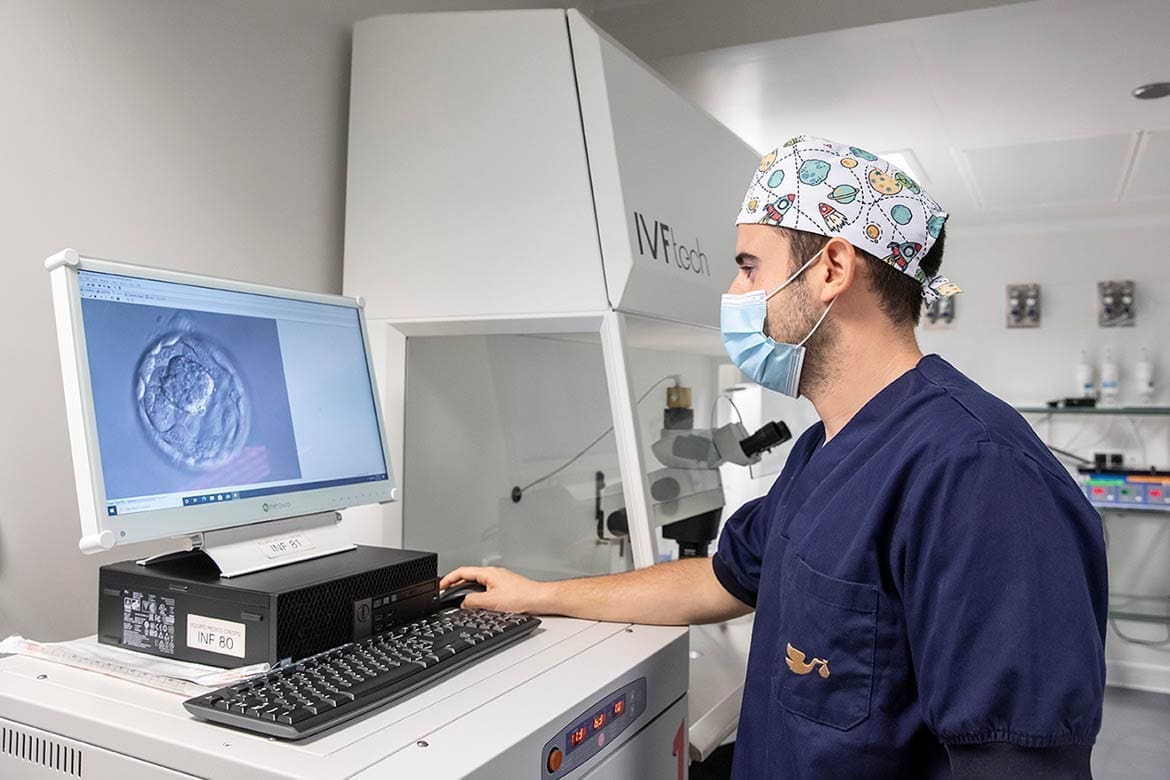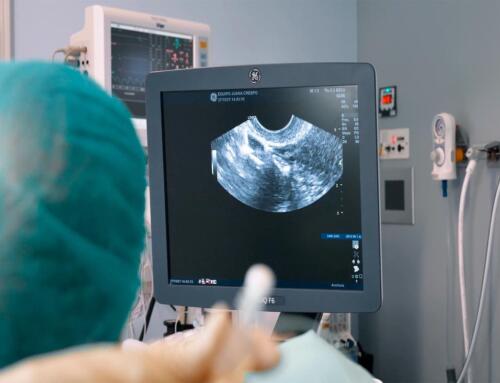The embryonic implantation is the process by which the embryo, already transferred into the mother’s uterus, attaches to the endometrium and penetrates into its interior to continue developing.
Also known as “nidation”, the implantation of the embryo usually takes place between 5 and 6 days after the egg is fertilized. Fertilization can be performed using two possible techniques:
- Conventional IVF
In the IVF laboratory, we will put the egg in contact with an already treated semen sample so that one of the sperm fertilizes the egg in a spontaneous and natural way.
- ICSI or Intracytoplasmic Sperm Injection Technique
Also carried out in our laboratory, after the selection of the “optimal” sperm, we will perforate the cortex of the egg and deposit the male gamete directly into the cytoplasm.
Embryo implantation in IVF treatments
Embryo implantation is one of the most important and delicate phases of assisted reproduction treatments such as In-Vitro Fertilization, egg donation or embryo adoption.
Its success depends on many aspects, the three most important being:
- The quality of the embryo.
- The receptivity of the uterus.
- The correct synchronization and interaction between both.
This last one is much more important than it seems and, therefore, the objective will always be to transfer high-quality embryos at the right time. Otherwise, the success of the implantation may be compromised, since the dialogue between the uterus and the embryo would not be adequate.
This is why our medical team carries out an exhaustive follow-up of the patient throughout the treatment, but especially during the endometrial preparation, scheduling the transfer at the time we consider most suitable for the mother-to-be.
The question is: when should the transfer be performed to ensure embryo implantation and what conditions should be present to make the uterus more receptive?
Implantation occurs when the embryo has reached the blastocyst stage. At that moment (5-6 days after fertilization), it has about 200-400 cells and is made up of two differentiated parts:
- The inner cell mass (which will give rise to the embryo).
- The Trophectoderm (external cells that will form the placenta and other embryonic attachments).
For implantation to take place, the endometrium must be perfectly prepared for implantation (with an endometrial thickness between 7-10 mm. and trilaminar aspect) and the molecules responsible for mediating the dialogue with the embryo (cytokines, integrins, adhesion molecules or growth factors, among others) must be expressed in the uterus.
The days of greatest endometrial receptivity are known as the “the implantation window” and include days 20-24 of the menstrual cycle in women with regular menstrual periods.

How long does it take and what are the stages of embryo implantation?
Embryo implantation lasts 4-5 days, from the time the blastocyst hatches until the embryo completely invades the endometrium to adhere to it. This occurs between days 5 and 10 of its development, in a process that consists of several phases:
- Hatching
Around days 5 and 6 of its development, the embryo “hatches” to shed its zona pellucida (or pellucid zone), an outer layer that protects it. When the embryo manages to emerge from the zona pellucida, it begins to interact with the endometrium.
- Opposition
Around the seventh day after fertilization, the embryo positions itself on the endometrial tissue.
Thanks to pinopods, a type of morphological markers that only appear during the window of implantation, the inner cell mass orients itself towards the endometrium to ensure the placenta’s development.
- Invasion and adhesion
Once the embryo has found its natural position, it displaces the epithelial cells and invades the endometrial stroma, coming into contact with the maternal blood.
At this moment, a “tear” is produced in the endometrium by which new endings are formed which amalgamate and allow the future embryo to adhere to the wall of the uterus for further development.
What are the signs that implantation has occurred?
Once the embryo has implanted, your body will begin to synthesize the beta-hCG hormone and, due to its effect, you may begin to experience some of the first symptoms of pregnancy (drowsiness or swelling, for example).
Some women also notice slight discomfort similar to menstruation, although without significant pain.
On the other hand, slight vaginal bleeding may occur. It is estimated that between 25 and 30% of women suffer from this small hemorrhage, known as “implantation bleeding” and which can be confused with abnormal menstruation, although there are differences between them.
In any case, the only reliable way to know if the embryo has implanted is to perform a blood test that will reveal the amount of beta-hCG hormone in the patient, approximately 10 days after the transfer. Depending on the values of this hormone, also known as “the Beta” or “the pregnancy hormone”, we will be able to confirm pregnancy.
If you want to undergo an assisted reproduction treatment and you have questions about embryo transfer, the embryo implantation process or other related issues, please contact us. We will be happy to answer your questions.
















